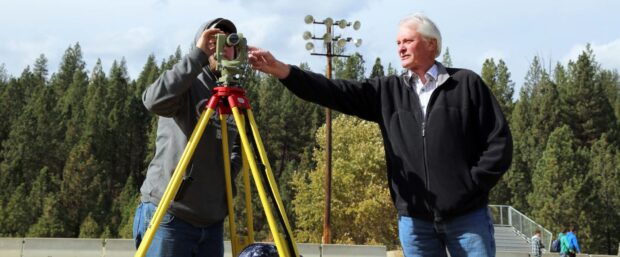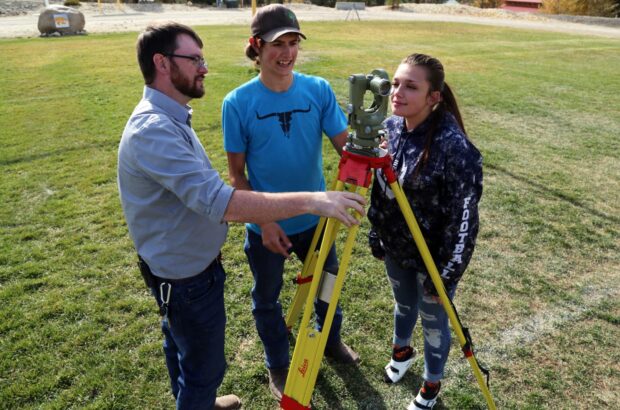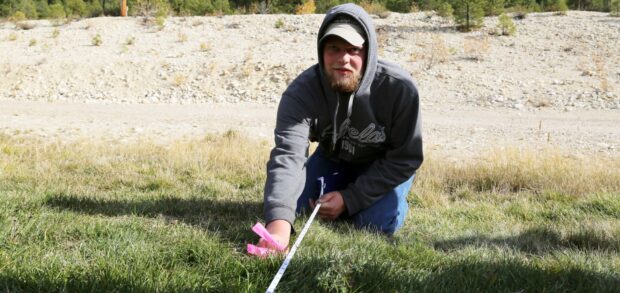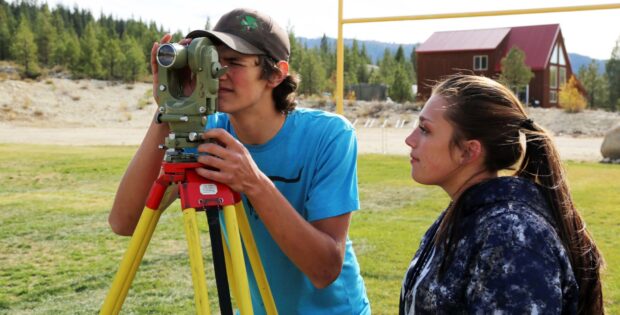IDAHO CITY — Nestled between ponderosa pine trees sits a remote football field in the Boise National Forest. It’s 43 degrees on a Thursday afternoon and 13 Idaho City High School students are scattered across the field measuring the solid white lines throughout the grass.
These students aren’t preparing for a football game. They’re taking records and exact measurements laying out the football field so its square.
This activity is part of a new year-long surveying trigonometry class offered at Idaho City High School.
“I never pictured myself doing this,” said senior Meadow Heffington. “I’m actually understanding math concepts while working with equipment.”
Glenn Bennett is a mentor to the class and is teaching students what it’s like to be a land surveyor — something he’s done for nearly 40 years. Bennett plans to retire next year and is concerned about his occupation’s future.
“The profession is dying,” Bennett said. “Surveyors have been poor about explaining to people what we do and how important it is to society.”
Land surveying
Every construction project starts and ends with a survey. Survey work is required when land is divided, purchased or sold, as well as when planning construction on a site. Nearly 260 land surveyors practice in Idaho and are an average age of 58 years old.
By 2024, the Idaho Department of Labor expects 248 land surveyor jobs to open in Idaho. Even as the technology has reduced the number of workers needed per survey job, the profession still is experiencing a deficiency of survey specialists.

“This is a nationwide problem,” Bennett said. “My goal is to get kids to be surveyors. Until we become more proactive in promoting the profession, nothing will change.”
Surveying trigonometry class
Bennett is taking his survey expertise to the classroom to inform and educate teens about what land surveyors do. Last year, Boise County Sheriff Jim Kaczmarek approached Bennett about speaking at Idaho City High School to discuss his career. That led to an outdoor activity for 32 students exposing them to the opportunities available in a surveying career. Students learned about the history of surveying, technology and education.
“Students were very enthusiastic about what they learned,” Bennett said.
Several students expressed an interest in pursuing a career in land surveying and superintendent John McFarlane along with math teacher Jayce Bell created a class to fill the need.
The surveying trigonometry class is based on curriculum from Idaho State University. The class is a combination of trigonometry, 3D mapping and fieldwork using equipment donated by local surveyors and the Idaho Transportation Department. Bennett is acting as an expert mentor for the students.

“It makes it far easier to motivate students to do traditional math problems when they’re doing hands-on assignments,” Bell said. “From my angle as a math teacher, I give them context and then they conduct what they learned while out in the field.”
On Tuesdays and Thursdays Bennett volunteers his time and teaches fieldwork to students. The rest of the week Bell teaches math principles using the exercises the students have done with the equipment. The class uses the same textbook as students in the Surveying and Geomatics Engineering program at Idaho State University. Bell is in discussions with Idaho State University to offer the surveying trigonometry class for dual credit next year.
“I had no examples of other schools doing this type of class in Idaho,” Bell said. “I’m learning as much as the kids are.”
Future projects will include establishing distance and elevation markers along hiking trails and performing a boundary survey of the Basin Library property as a final project.


